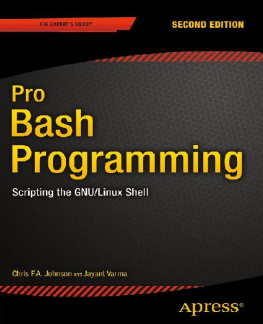Acknowledgments
A book like this cannot be written without help from many people. Three in particular played key roles. First and foremost, I want to thank my wife, Robbie, for her patient and thorough job of editing. A journalist and editor by profession, she steered me reliably toward clarity and vividnessand away from academic jargon and dry explanation. Second, I am indebted to my agent, Michael Snell, for his encouragement, upbeat attitude, and careful tutoring as we moved this project from concept to finished product. He was a knowledgeable guide to the mysteries of trade book publishing. Finally, I want to recognize my editor at Viking Penguin, Jane von Mehren, for believing in Bargaining for Advantage, improving it with her editorial direction, and providing a cheerful, professional hand throughout. Her sense of humor reminded me to keep mine.
During the manuscript phase, a number of friends and colleagues gave generously of their time to read and comment in detail on drafts. Special thanks go to Simon Auster, Peter Cappelli, Eric Orts, Maurice Schweitzer, and Michael Wheeler. In addition, Larry Susskind, James J. White, Robert Cialdini, Tom Dunfee, Alan Strudler, Stuart Diamond, Howard Kunreuther, Bob Mittelstaedt, Michael Stein, Leslie Goode, and Tod Ibrahim also read all or parts of the manuscript and made useful suggestions. Wharton MBA students in my fall 1997 and spring 1998 negotiation courses, as well as executives in the Wharton Executive Negotiation Workshop during the same and earlier periods, gave me comments and provided memorable stories to include as illustrations. Jon A. Bjornson assisted on graphic design elements of the book.
Two members of the Wharton Legal Studies Department office teamour business administrator, Tamara English, and my administrative assistant, Andrea Kingtirelessly and patiently typed, proofread, and assembled drafts as the manuscript took shape. My thanks for their cheerful help. Jeremy Bagai, Bernadette Spina, Tracy Denton, and Brian Okay contributed outstanding research assistance.
Bargaining for Advantage reflects an intellectual journey as well as a writing project. I owe a particular debt to Professor Robert B. Cialdini, whose book Influence: The Psychology of Persuasion opened my eyes to lines of social psychological research that turned out to be especially relevant to negotiation. Cialdinis book also provided a model for making social science research both readable and entertaining. In addition, my colleague Stuart Diamond, with whom I teach in the Wharton Executive Negotiation Workshop, is always challenging my perspectives on the subject. His insistence on the importance of daily practice, personality styles, and standards led me to investigate these aspects of negotiation training and effectiveness more deeply than I might otherwise have done.
Finally, I have benefited over the past decade from many professional associations with leaders in the negotiation and conflict resolution fields. I had a particularly interesting academic experience as a Visiting Scholar at the Harvard Program on Negotiation in the 1993-1994 academic year. I also want to give special thanks to Larry Susskind (MIT), Len Greenhalgh (Dartmouth), Howard Raiffa (Harvard Business School), Max Bazerman (Kellogg School at Northwestern University), and Roy Lewicki (Ohio State University). These scholars introduced me to the subject of negotiation in its academic setting, generously shared teaching materials with me in the early going, and pointed me toward the intellectual and practical questions that make the field so interesting.
G. RICHARD SHELL
Appendix A:
Bargaining Styles Assessment Tool
Follow this four-step process to determine your personal bargaining style preferences.
1. Without giving the matter too much thought (and without revising your answers for any reason!), please select ONE STATEMENT in each pair of statements below. Select the statement you think is more accurate for you when you face a negotiation or disagreement with someone elseeven if you think neither statement is very accurate or both are very accurate. Think about such situations in generalnot just ones at work or at home. And dont pick the statement you ought to agree withpick the one your gut tells you is more accurate for you most of the time. Some statements repeat, but do not worry about answering consistently. Just keep going. All answers are equally correct.
2. After selecting a statement from every pair, go back and add up the total number of As, Bs, Cs, Ds, and Es you recorded. Put the totals in the Results space at the end of the survey.
3. Plot your total scores on the Evaluation Grid provided. Connect each of the numbers you circle with lines to make a simple graph. Your strongest inclinations will plot at the top of the graph while your weakest inclinations will plot near the bottom.
4. Return to the Chapter 1 text, or continue reading in this Appendix for a more in-depth explanation of your scores and the general subject of bargaining styles.
STEP 1 : STYLE SURVEY
STEP 2 : RECORD RESULTS
Add up all your A, B, C, D, and E answers on the previous pages and put those totals below:
STEP 3: PLOT YOUR SCORES
Find and circle the numbers on the following grid that correspond to your scores for each of the five letters. Circle your A score in the first vertical column on the left side of the grid marked CompetingA. Circle your B score in the next vertical column marked CollaboratingB, and so on over to the last vertical column on the right, which is for your E or Accommodating score.
Once you have one circle in each column of the grid, connect these five circles with straight lines so you have created a simple graph. Scores at the top of the graph (usually those above the 70th percentile) are your strongest bargaining style inclinations. Scores at the bottom of the graph (usually below the 30th percentile) are your weaker bargaining style inclinations. All scores between the 30th and 70th percentiles represent moderate, functional bargaining style inclinations. And the higher or lower the percentile, the stronger the inclination to use that move in ordinary negotiations.
For deeper insight into bargaining styles, their origins and their meanings, continue reading in Appendix A. First-time readers may want return to Chapter 1 and pick up the theme of bargaining styles there, leaving the further study of this subject for later.
FURTHER ANALYSIS OF YOUR PERSONAL BARGAINING STYLES
Interest in personal bargaining styles and the use of assessment instruments to probe this factor date back almost as far as do organized courses on negotiation. The reason is simple: bargaining styles can play crucial roles in negotiation. Entrepreneur Donald Trump is well known to be (and takes pride in being) competitive to his core. Cable News Network personality Larry King is well known to be (and takes pride in being) empathetic and easy to get along with. If these two men were to find themselves negotiating against one another, both would be wise to think about their own and their counterparts bargaining styles before making a move.
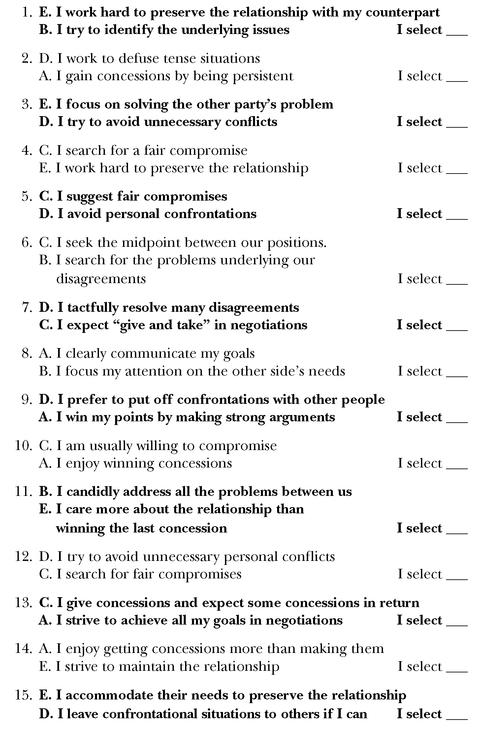
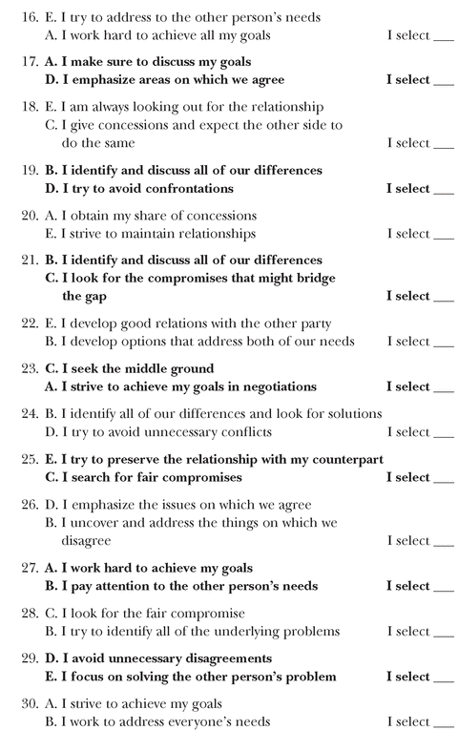
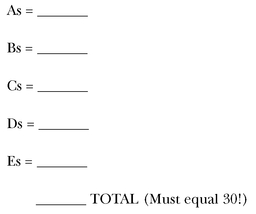
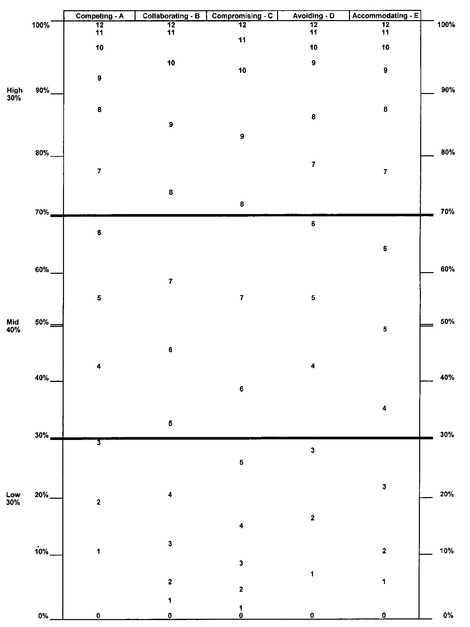



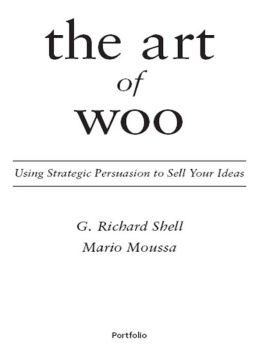


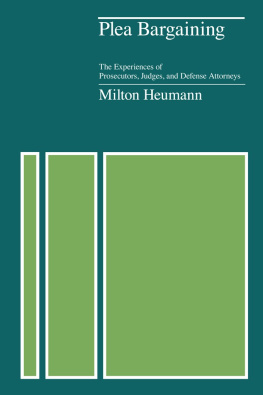

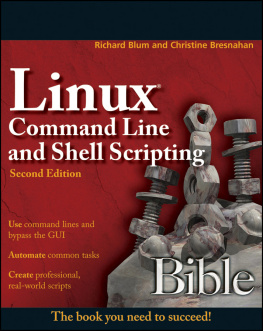

![Chris F.A. Johnson [Chris F.A. Johnson] - Pro Bash Programming: Scripting the GNU/Linux Shell](/uploads/posts/book/119669/thumbs/chris-f-a-johnson-chris-f-a-johnson-pro-bash.jpg)
